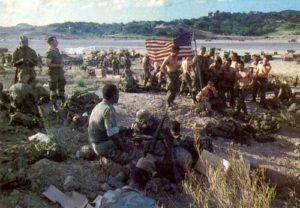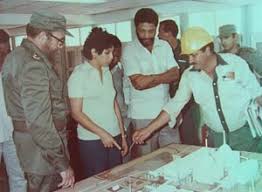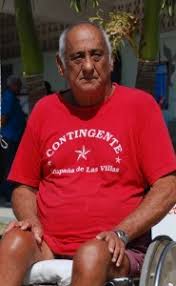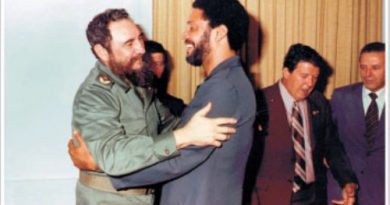 CASTRO Y PEDRO TORTOLÓ: HACE 35 AÑOS, FIASCO MILITAR EN GRENADA. SU HISTORIA.
CASTRO Y PEDRO TORTOLÓ: HACE 35 AÑOS, FIASCO MILITAR EN GRENADA. SU HISTORIA.
A las 5:00 a.m. del 25 de octubre de 1983, fuerzas del Ejército de Estados Unidos con el respaldo de una coalición de dispositivos militares de seis países caribeños iniciaron la invasión a la isla de Granada. La operación ‘Urgent Fury’, ordenada por el presidente Ronald Reagan, involucró a 7,000 militares estadounidenses y 300 hombres de la Organización de Estados del Caribe Oriental (OECO), en lo que resultó el mayor despliegue realizado por tropas norteamericanas desde la Guerra de Vietnam.
Las fuerzas invasoras encontraron una leve resistencia de 1,500 soldados granadinos y unos 700 cubanos, la mayoría obreros de la construcción y alrededor de 60 militares. Eran los días de euforia militar de Fidel Castro, envalentonado por sus incursiones en Angola y Etiopía, y la expansión de sus tentáculos por Centroamérica. De manera que el ‘Estratega en Jefe’ concibió la idea de confrontar las tropas norteamericanas y defender las posiciones cubanas en el aeropuerto de Point Salines.
Frases Populares Cubanas: “Corrió como Tortoló”.
Fidel Castro conocía a el coronel Pedro Benigno Tortoló Comas desde las maniobras militares Bastión, a comienzos de los años 80, y especialmente estuvo muy cerca de él durante los ejercicios desarrollados en 1983. En el recorrido realizado por diferentes puestos de mando de la defensa, Castro llegó a la antigua escuela de responsables de milicias del Ejército Central, que tenía a Tortoló como jefe del Estado Mayor de esa fuerza militar.
Al arribar Castro, le rinden el parte correspondiente de las supuestas acciones militares y como jefe del Estado Mayor le informa de las tácticas y maniobras a seguir para contrarrestar una posible invasión enemiga. Tortoló lo hace bien y responde sin titubeos a las incisivas preguntas del gobernante, que se lleva una magnífica impresión del joven coronel.
El 14 de octubre Bishop es depuesto y asesinado por las fuerzas leales a Bernard Coard en Granada y se desata una ola de violencia en la nación caribeña. Ante la inminente intervención militar por parte de Estados Unidos y fuerzas conjuntas de estados caribeños como Barbados, Dominica y Jamaica, Fidel Castro decide no retirar ni un solo cubano de Granada y enviar a un militar de alta graduación para hacerse cargo de la defensa en las posiciones cubanas en el territorio granadino, fundamentalmente el aeropuerto en construcción en Point Salines y la embajada cubana.
En el despacho de Fidel Castro
El nombre que le viene a la mente en ese momento es el de aquel jefe del Estado Mayor del Ejército Central que pocos días ante le había dado una brillante disertación en las maniobras para repeler cualquier “invasión enemiga”. De esta forma se decide la suerte de Tortoló. El coronel es citado para el despacho de Castro en el Consejo de Estado, donde Castro personalmente le da las órdenes que debía ejecutar a su llegada a Granada.
Recuerdo claramente, como si fuera hoy, aquel encuentro y las apremiantes recomendaciones hechas por Castro:
A.- Sin perder un minuto, organizar a los cubanos en las diferentes zonas para la defensa de las instalaciones y distribuir todas las armas que allí se encontraban.
B.- Establecer un sistema de comunicaciones entre las posiciones y la embajada cubana, a fin de mantener informada a La Habana sobre los posibles acontecimientos que se desarrollaran.
C.- Lo más importante: no atacar a las fuerzas enemigas si no eran atacados directamente.
Fidel Castro le insistió que debía defender sus posiciones a toda costa “hasta el último hombre y la última bala”, aún con el conocimiento de que no podía contar con refuerzos desde Cuba, previendo el bloqueo naval que se implantaría a la isla. En otras palabras, significaba que en caso de enfrentamiento armado, sería combatir hasta el final. Un suicidio anunciado.
Con estas órdenes en la cabeza, el coronel Tortoló partió del aeropuerto del escuadrón ejecutivo de Playa Baracoa, al oeste de la capital cubana, en un avión AN-26 que lo trasladó a la isla de Granada, en la madrugada del 24 de octubre de 1983. Para esa fecha, Bishop ya había sido ultimado.
Inmolados y aferrados a la bandera
Todos los partes recibidos por Fidel Castro a través de la embajada cubana en Granada, donde se encontraba como embajador Julián Enrique Torres Rizo, eran devastadores y potencialmente exagerados, hasta el punto de informar que el último reducto de resistencia cubana se había inmolado, abrazados todos sus integrantes a la enseña nacional.
¿Por qué Fidel Castro no retiró al personal cubano de Granada una vez que Bishop fue asesinado, cuando incluso él mismo había expresado que las relaciones con Bernard Coard y su gobierno eran frías y distantes? ¿Por qué no aprovechó esa cobertura y salvó a decenas de cubanos de resultar muertos y heridos en una contienda que no tenía más salida que la inmolación?
Ciertamente Fidel Castro no movió un dedo en buscar una evacuación de los cubanos mediante una coordinación diplomática con las fuerzas invasoras. No porque no había tiempo -como expresó después- sino porque desde un principio esa variante no estuvo en sus planes. Castro sabía que los cubanos no contaban con el armamento, ni la preparación, ni la experiencia necesaria para hacer frente y frenar un posible ataque a las posiciones que ocupaban en territorio granadino.
La verdadera intención de Fidel Castro era que, si Estados Unidos se decidía por no atacar las posiciones cubanas, los 700 efectivos desplegados allí regresarían a Cuba como verdaderos héroes y se esgrimiría el argumento victorioso de que el imperialismo no había osado atacarlos. En caso de ser atacados, ofrecerían resistencia “hasta el último hombre y la última bala”, como le había ordenado a Tortoló, y entonces desataría una campaña internacional en contra del presidente Ronald Reagan para desacreditarlo y tildarlo de abusador y asesino.
Pero las cosas no le salieron como esperaba. Tortoló no tuvo nunca la decisión de inmolarse ante una causa que ya se había perdido desde antes que lo enviaran a Granada.
Recuerdo el rostro de preocupación y el desasosiego que acompañó a Fidel Castro por esos días tras las evidencias de la aplastante derrota.
Según se supo luego mediante las investigaciones realizadas personalmente por Fidel y Raúl Castro, Tortoló nunca dio la orden de fuego contra las posiciones enemigas. La pesquisa fue conducida por los dos hermanos mediante entrevistas a testigos de los acontecimientos, incluido el propio Tortoló, en la Casa 28 de protocolo del Consejo de Estado, situada en las calles 150 y 21 del municipio Playa, en La Habana.
Los interrogatorios confirmaron que Tortoló recorría las posiciones durante el enfrentamiento, desatado realmente por las fuerzas granadinas de resistencia. Al ver que los cubanos no les disparaban a las tropas invasoras, los granadinos comenzaron a hacerle fuego a a las posiciones cubanas para buscar una reacción. Algunas posiciones cubanas abrieron entonces fuego por su cuenta, sin tener la orden específica del mando inmediato.
El saldo de esta lamentable escaramuza militar fue de 19 soldados estadounidenses, 25 cubanos y 45 granadinos del Ejército Revolucionario del Pueblo (PRA) fallecidos. También murieron 24 civiles de Granada. Entre los cubanos hubo 59 heridos y 638 prisioneros.
Poco le duraron al coronel Tortoló las horas de gloria después que fuera recibido como un héroe por el propio Fidel Castro en el aeropuerto de La Habana, donde rindió el parte de la “misión cumplida”. Después de las investigaciones realizadas, fue recriminado por Fidel y Raúl castro en la mencionada Casa 28 y enviado a un tribunal de honor que lo degradó a soldado, junto con todos los militares cubanos que estaban en Granada.
Como alternativa se les impuso limpiar su honor en la guerra de Angola, donde combatió Tortoló y se ganó los grados de sargento. Hoy vive sin gloria y con pena en su casa de la calle Marino en La Habana, a los 72 años.
Toda la responsabilidad de este inútil enfrentamiento cubano con la 82 División Aerotransportada del Ejército de Estados Unidos recae sobre la conciencia de Fidel Castro y de su hermano Raúl. Aunque Tortoló cargará siempre con el estigma del hombre que huyó, no fue más que el chivo expiatorio de este monumental fiasco militar cubano en el Caribe.
Después de Granada, la imagen de la invencibilidad cubana y la retórica de la inmolación patriótica quedaron severamente dañadas. Y eso es lo que Fidel Castro no podía perdonar.
 AUTOR: Juan Reynaldo Sánchez fue escolta personal de Fidel Castro entre 1968 y 1994, con grados de teniente coronel. Fue destituido y cumplió prisión en Cuba. Logró abandonar la isla en el 2008 y residió en Miami hasta su fallecimiento en 2015. Su libro testimonial La vida oculta de Fidel Castro (2014) resume sus experiencias de 17 años en la seguridad personal del gobernante cubano, y ha sido publicado en varios idiomas.
AUTOR: Juan Reynaldo Sánchez fue escolta personal de Fidel Castro entre 1968 y 1994, con grados de teniente coronel. Fue destituido y cumplió prisión en Cuba. Logró abandonar la isla en el 2008 y residió en Miami hasta su fallecimiento en 2015. Su libro testimonial La vida oculta de Fidel Castro (2014) resume sus experiencias de 17 años en la seguridad personal del gobernante cubano, y ha sido publicado en varios idiomas.
 CASTRO AND PEDRO TORTOLÓ: 35 YEARS AGO, MILITAR FIASCO IN GRENADA. ITS HISTORY.
CASTRO AND PEDRO TORTOLÓ: 35 YEARS AGO, MILITAR FIASCO IN GRENADA. ITS HISTORY.
At 5:00 am. On October 25, 1983, US Army forces backed by a coalition of military devices from six Caribbean countries began the invasion of the island of Granada. The ‘Urgent Fury’ operation, ordered by President Ronald Reagan, involved 7,000 US servicemen and 300 men from the Organization of Eastern Caribbean States (OECS), in what turned out to be the largest deployment by US troops since the Vietnam War. .
The invading forces found a slight resistance of 1,500 soldiers from Granada and some 700 Cubans, most of them construction workers and around 60 soldiers. Those were the days of Fidel Castro’s military euphoria, emboldened by his incursions into Angola and Ethiopia, and the expansion of his tentacles through Central America. So the ‘Chief Strategist’ conceived the idea of confronting US troops and defending Cuban positions at the Point Salines airport.
Cuban Popular Phrases:” It ran like Tortoló “.
Fidel Castro knew Colonel Pedro Benigno Tortoló Comas from the military maneuvers Bastion, at the beginning of the 80s, and especially was very close to him during the exercises developed in 1983. In the tour made by different defense command posts, Castro arrived at the former school of militia officers of the Central Army, who had Tortoló as the chief of staff of that military force.
When Castro arrives, he is given the corresponding part of the alleged military actions and as chief of the General Staff he informs him of the tactics and maneuvers to follow to counteract a possible enemy invasion. Tortoló does it well and responds without hesitation to the incisive questions of the ruler, who gets a magnificent impression of the young colonel.
On October 14, Bishop is deposed and assassinated by forces loyal to Bernard Coard in Granada and a wave of violence is unleashed in the Caribbean nation. Given the imminent military intervention by the United States and joint forces of Caribbean states such as Barbados, Dominica and Jamaica, Fidel Castro decided not to remove a single Cuban from Granada and send a high-ranking military to take charge of the defense in the Cuban positions in the territory of Granada, mainly the airport under construction in Point Salines and the Cuban embassy.
The name that comes to mind at that time is that of the Chief of Staff of the Central Army who a few days before had given him a brilliant dissertation in the maneuvers to repel any “enemy invasion.” In this way the fate of Tortoló is decided. The colonel is summoned to Castro’s office in the Council of State, where Castro personally gives him the orders he was to execute upon his arrival in Granada.
I remember clearly, as if it were today, that meeting and the urgent recommendations made by Castro:
A.- Without losing a minute, organize the Cubans in the different zones to defend the facilities and distribute all the weapons that were there.
B.- Establish a communications system between the positions and the Cuban embassy, in order to keep Havana informed about the possible events that will take place.
C.- The most important thing: not to attack enemy forces if they were not attacked directly.
Fidel Castro insisted that he must defend his positions at all costs “until the last man and the last bullet”, even with the knowledge that he could not count on reinforcements from Cuba, foreseeing the naval blockade that would be implanted on the island. In other words, it meant that in case of armed confrontation, it would be to fight until the end. An announced suicide.
With these orders in his head, Colonel Tortoló departed from the airport of the executive squadron of Playa Baracoa, west of the Cuban capital, on an AN-26 plane that took him to the island of Granada, in the early hours of October 24, 1983. By that date, Bishop had already been killed.
Immolated and clinging to the flag
All the parts received by Fidel Castro through the Cuban embassy in Granada, where he was as ambassador Julian Enrique Torres Rizo, were devastating and potentially exaggerated, to the point of reporting that the last redoubt of Cuban resistance had been immolated, embracing all its members to the national banner.
Why did not Fidel Castro remove the Cuban personnel from Granada once Bishop was assassinated, when even he himself had expressed that relations with Bernard Coard and his government were cold and distant? Why did not take advantage of this coverage and saved dozens of Cubans from being killed and wounded in a race that had no other way out than the immolation?
Certainly Fidel Castro did not move a finger to seek an evacuation of the Cubans through diplomatic coordination with the invading forces. Not because there was no time, as he said later, but because from the beginning that variant was not in his plans. Castro knew that the Cubans did not have the weapons, training, or experience necessary to face and stop a possible attack on the positions they occupied in Granada.
The real intention of Fidel Castro was that, if the United States decided not to attack the Cuban positions, the 700 troops deployed there would return to Cuba as true heroes and would use the victorious argument that imperialism had not dared to attack them. If attacked, they would offer resistance “to the last man and the last bullet,” as he had ordered Tortoló, and then unleash an international campaign against President Ronald Reagan to discredit him and label him an abuser and murderer.
But things did not turn out as expected. Tortoló never had the decision to sacrifice himself to a cause that had already been lost before being sent to Granada.
I remember the face of worry and restlessness that accompanied Fidel Castro in those days after the evidence of the overwhelming defeat.
As it was later learned through investigations conducted personally by Fidel and Raúl Castro, Tortoló never gave the order to fire against the enemy positions. The investigation was conducted by the two brothers through interviews with witnesses of the events, including Tortoló himself, in the 28th House of Protocol of the Council of State, located at 150 and 21st streets of Playa municipality, in Havana.
The interrogations confirmed that Tortoló went through the positions during the confrontation, really unleashed by the Granada forces of resistance. Seeing that the Cubans did not shoot at the invading troops, the Grenadians began to fire the Cuban positions to seek a reaction. Some Cuban positions then opened fire on their own, without having the specific order of immediate command.
The balance of this unfortunate military skirmish was 19 US soldiers, 25 Cubans and 45 Grenadians from the Revolutionary People’s Army (PRA) died. 24 civilians from Granada also died. Among Cubans there were 59 wounded and 638 prisoners.
Colonel Tortoló lasted little time after he was received as a hero by Fidel Castro himself at the airport in Havana, where he performed the “mission accomplished” part. After the investigations, he was recriminated by Fidel and Raul Castro in the aforementioned House 28 and sent to a court of honor that degraded him to a soldier, along with all the Cuban soldiers who were in Granada.
As an alternative, they were forced to clean up their honor in the Angolan war, where they fought Tortoló and earned the rank of sergeant. Today lives without glory and with grief in his house on the street Marino in Havana, at 68 years.
All the responsibility of this useless Cuban confrontation with the 82nd Airborne Division of the United States Army falls on the conscience of Fidel Castro and his brother Raúl. Although Tortoló will always bear the stigma of the man who fled, he was no more than the scapegoat of this monumental Cuban military fiasco in the Caribbean.
After Granada, the image of Cuban invincibility and the rhetoric of patriotic immolation were severely damaged. And that is what Fidel Castro could not forgive.
 AUTHOR: Juan Reynaldo Sánchez was the personal escort of Fidel Castro between 1968 and 1994, with degrees of Lieutenant Colonel. He was dismissed and served prison in Cuba. He managed to leave the island in 2008 and resided in Miami until his death in 2015. His testimonial book The Hidden Life of Fidel Castro (2014) summarizes his experiences of 17 years in the personal security of the Cuban ruler, and has been published in several languages .
AUTHOR: Juan Reynaldo Sánchez was the personal escort of Fidel Castro between 1968 and 1994, with degrees of Lieutenant Colonel. He was dismissed and served prison in Cuba. He managed to leave the island in 2008 and resided in Miami until his death in 2015. His testimonial book The Hidden Life of Fidel Castro (2014) summarizes his experiences of 17 years in the personal security of the Cuban ruler, and has been published in several languages .
Agencies/Café Fuerte/Juan Reynaldo Sánchez/ Internet Photos/ Arnoldo Varona/ THeCubanHistory.com
THE CUBAN HISTORY, HOLLYWOOD.












